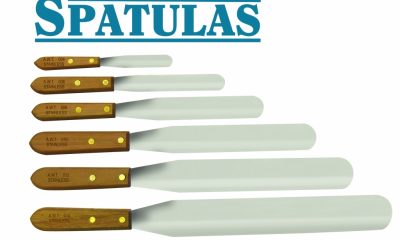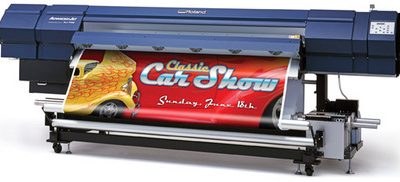Business & Industry
Published
16 years agoon
Long-time readers of this publication may remember that I addressed the issue of business slowdowns a few years ago. Well, I’m at it again—with a slightly different twist—because I feel that it is one of the most important issues screen-printing business owners face. Businesses in general, but especially screenprinting businesses, have a tendency to forgo planning for non-seasonal business cycles. I speak from personal experience. I too was blindsided by a credit crunch/ business downturn in the early 1990s. I hope that this article will help you avoid the major trauma that these downturns can cause.
As you may have noticed, the doom-and-gloom group is getting a lot of press time these days. The mortgage crisis, the sinking dollar, the stock market, and other factors are creating an edginess that has infected the media and is starting to trickle down into the general public. I hate this self-fulfilling prophesy garbage myself. Most of the time, the only thing really wrong in the economy is the people who want to see it collapse. But the media loves a story, and they will make one if they cannot find one on their own.
What does this mean to screen printers? It means quite a bit actually. But it does not have to be negative. Every time there is an economic slowdown, companies and individuals look for ways to conserve capital and stay afloat. At the same time, your customers cannot just shut off the ad budgets, or they will die. What they must do is find the most effective ways to advertise and cut down on the frills. Since screen printing represents one of their advertising sources, the key for us is to make sure we are chosen as a place where they continue to spend their promotional dollars.
Most printers are now heading into their slower season. What better time to take a few minutes to think about how efficient your business is running instead of being slapped with a slowdown during peak times, when you are trying to make the profits necessary to support the business for the rest of the year?
Companies that fall during an economic slowdown generally do so because they fail to react, either in time or at all, to the market conditions that affect their business. For instance, if you’ve charged through the summer with high staff levels because you have lots of work, now is not the time to take low-margin business just to keep everyone busy. Instead, it is time to get a lot more conservative with your staffing decisions. Hopefully, it will not come to laying off your good people, but instead to allow attrition to take its course and not replace those who depart. If things do get worse, layoffs may be the only way to go.
If there is no downturn, however, or if it is more moderate than you plan for, there is no negative to being prepared. You will not be caught in an unworkable situation. Instead, you will be able to gear right back up and go for the business—albeit with a healthy company, rather than one that has been stressed to the breaking point.
Business health
You can determine the health of your business in many ways. Consultants get paid big money to help companies through rough periods. I am not advocating the use of a consultant. Instead, I am saying that common sense is just as good a tool as any. If your business is doing well and making money, and if it has survived previous slowdowns, I can almost guarantee that you have the right stuff to help you through it again. If your business is young and you haven’t yet seen a downturn, then caution is definitely the watchword right now.
I have put together a short checklist of indicators that I feel are im-portant to watch at the beginning of any slowdown. Most of these indicators actually apply any time and should be looked at often. But during a downturn, they are essential. They are:
• Accounts receivable aging
• Cash flow
• Employee satisfaction
• Business backlog
• Inventory levels
• New customer business percentage/
order inquiry rate
• Prior year business comparison
Accounts receivable aging
If your company is big enough to have a person whose main responsibility is to tend to accounts receivable, now is the time to make sure you are getting a copy of the numbers every day. A monthly update is no longer good enough. Even if all you do is look at the totals, you will be much more in tune to what is going on and which way things are headed.
If your company is smaller and you take care of the aging (a periodic report that shows outstanding receivable balances, organized by customer and month due) yourself, it is now a daily task. Accounts receivable can get upside down very quickly. And if your customers consider you a minor vendor, payments will come to you much later, when their cash is short, than to their more important suppliers. Think about how you would react in the same situation. When your cash is tight, who do you push aside and whom do you make sure gets paid first? The usual rule of thumb is wages first, primary materials vendors second, utilities and phone third, minor vendors last.
I would be willing to bet that very few screen-printing or digital-imaging companies qualify as primary vendors to their customers. It is important to keep that in mind–even in the good times.
Cash flow
If you have money in the checking account after paying all the bills, then your cash flow is good—today. Do you know what it will be like tomorrow, or next week? Order volume, accounts payable, and accounts receivable all impact your cash flow. Keeping the number positive is one of the major challenges of any business. Cash flow usually suffers right away in any economic downturn. If you think about the seasonal changes in your business and the impact that these fluctuations have on your cash flow, then you will begin to understand what I am talking about. Most downturns are like seasonal changes on steroids.
Employee satisfaction
Employees are not immune to what is going on in the economy. They all hear and see the news, and while some may not pay close attention, they all talk at work. The best way to discover what is going on with your staff is to ask them. Communication is a great tool to both confirm your suspicions and to allay the staff’s fears. If they know you are concerned and paying attention, they will be more confident about the future. Confident employees are far more productive than worried employees. And the last thing you need when things are slower is lower productivity.
Employees are also a great source of information about what is happening to their friends at other companies and in other industries. When things slow down, other businesses are impacted as well. Layoffs and reduced hours will probably show up in other companies before you have to consider similar actions. Advanced warning is always a good thing.
Business backlog
Common sense says that if your backlog is shrinking, business is slowing down. It takes a good manager to decide whether it is a normal seasonal slowdown or a downturn-related slowdown. Your own salespeople and direct customer discussions can fill in the blanks. Customers will generally be quite open about why they are all of a sudden buying less. Budget cutbacks, changes in marketing philosophy or direction, and product redesign are all indicators from your customers of slowing business.
Inventory levels
Several different kinds of inventory require review: your inventory of supplies and substrates, your finished inventory of customer goods, and your customer’s own finished goods inventories. If you maintain finished goods for your customers, you have an inside track on seeing market trends. When outgoing shipments slow down, it is a great indicator that the customer’s business is slowing down. I used to maintain a large fulfillment inventory for several customers, and I could see the slowdowns in their business coming very early because I saw the decrease in their shipments from my inventory even before their ordering slowed down. This fulfillment inventory is an ideal indicator; unfortunately, it is not one that all print providers can take advantage of. Many of us print and ship, so we must rely on the other indicators.
If you don’t know what your customer is maintaining, ask them. Very few customers would be so secretive that they would not tell you what their trends are with your merchandise. By explaining that you are trying to stay ahead of the curve on how business is trending, you are showing that you are being proactive in trying to help them. It will bode well for your relationship when business improves.
New customer business/order inquiries
Are you still bringing in new customers? Most companies can chart their new customer percentages over time quite easily. With my company, I used to get four or five new customer inquiries each week that resulted in one to three new customers every week. When the numbers start to drop at your shop, that’s a good indication that fewer people are shopping. When shopping drops, you can bet there’s a downturn in progress.
Some may argue that shopping actually goes up when the economy slows. This phenomenon may occur in the short term, but what will happen is that inquires may rise, but actual new orders will not. Lots of lookers, not a lot of buyers.
Prior year comparison
Just about everyone is tuned in to comparing sales from year to year. The point here is to do it by customer and business type to see exactly what is slowing down. For a textile printer, a slowdown in adspecialty sales without a slowdown in custom sales may indicate the start of a slowdown—but a moderate one. If all markets start to slow, then it may indicate that the downturn will be more pronounced.
None of these indicators is any good on its own. Think of indicators as a group, along with any others that you may find helpful. Printers who have a small customer base are much more vulnerable to a slowdown than printers who have a large, diversified customer base. However, in a major downturn, no one is immune.
Other company types
Up until now we have focused on screenprinting companies that create products for other companies to use in advertising and promotion. What about other types of companies? How do you know when things are slowing down? The same logic persists. Orders will slow or get smaller, your accounts receivable aging may grow, shopping will increase, etc.
A textile printer that specializes in preprint merchandise may actually be the first to see the start and potential severity of a business-cycle slowdown. Their customers are retailers, and they tend to take the first hit in any slowdown. Lookat how closely the media and stock market tack the numbers in retail sales. It’s a great indicator.
Screen printers who create subassemblies or decorate products for other businesses will also see the slowdown early as their order sizes will drop quickly. I spoke with one printer recently who produces appliance front panels. He mentioned that he has seen a drop in order size and a flurry of new products—in small numbers. It sounds like his customer is not only experiencing a slowdown, but is also preparing for tough times by being more innovative to protect market share.
Regardless of which business type you operate, you will have access to early indicators. They key is seeing them for what they are and taking the proper steps to ensure that you are not hanging out too far to recover.
Slowdown confirmed. Now what?
If you’ve been watching and preparing, the big downturn should not come as a surprise—nor should it cause you undue concern. Survival and conservative business philosophy is now the order of the day. I will caution you to avoid one of the major pitfalls of this situation. Many companies and managers have a tendency to put their heads in the sand when things are tough. This approach is only asking for trouble.
Good ideas, new products, and quality employee prospects don’t just come your way in a boom. In fact, you’re much more likely to see more of all these things during a slowdown. Remember that your vendors, competitors, and customers are all trying to survive, so they are more likely to be innovative. Many of the great ideas in industry happen during a crunch. During boom times, everyone is just trying to get the work out. When work is slow, there is time to think.
Another way to look at this situation is to use a downturn as an opportunity, rather than a yoke. If you can come up with new approaches to business or new product ideas, you will be more competitive. New approaches may improve your productivity, and new products may win new customers—even if they are a scarce commodity. The only companies and managers that won’t survive are the ones who batten the hatches and do nothing. Innovators will trump them every time.
American automobile manufacturers serve as a perfect example of companies that have not done a good job of adapting and innovating during downturns. They have seen their market share sink like a rock through several business cycles because they are slow or late to innovate. The only reason they survived to this point at all is their massive size. The Big Three certainly missed the boat on the recent business turn that was caused by the rapid increase in fuel prices. They were all sitting with lots full of SUVs at the same time that customers were looking for fuel-efficient alternatives.
Screen printers can fall into the same trap. If you barrel along with high prices and long lead times instead of adjusting for the changes in the market, it could prompt your customers to look elsewhere. They’ll eventually find the print shop that comes to them with promises of shorter lead times, lower prices, and maybe lower minimums.
Remember that when things are tight, a key strategy may be to relax your minimums so that your customers still order something. Something is certainly better than nothing. I have been in discussions where the decision was made to use a different product because the order minimums on the previous product were too high. They were fine when we could sell all we bought. They were not so good when inventories started to rise.
Adapting to help your customer is one of the best ways to build loyalty and customer satisfaction. Not bending is a good way to break.
Common sense
As I mentioned in the beginning, watching for slowdowns and market changes is pretty much common sense. You needn’t be a rocket scientist, nor must you have an MBA, to see when markets slow down and adjustments need to be made. The keys are taking positive steps, but also not over reacting and leaving yourself too lean to compete and/or provide for your customers.
The silver lining is that even if the slowdown is short-lived or does not really affect your business at all, the preparation for what might have happened should still be of help. In fact, the prep work is actually quite healthy. To be prepared for eventualities is prudent. To blissfully work on without worry is folly.
Mike Ukena is a 15-year screen-printing veteran who has owned a textile-printing company and worked in technical services for the Specialty Graphic Imaging Association Int’l as the director of education. A member of the Academy of Screen Printing Technology, Ukena is a frequent speaker on technical and management topics at industry events. He is currently a technical sales representative for Union Ink Co., Inc.

Subscribe

Magazine
Get the most important news
and business ideas from Screenprinting Magazine.
Most Popular
-

 Case Studies2 months ago
Case Studies2 months agoHigh-Density Inks Help Specialty Printing Take Center Stage
-

 Art, Ad, or Alchemy2 months ago
Art, Ad, or Alchemy2 months agoF&I Printing Is Everywhere!
-

 Andy MacDougall2 months ago
Andy MacDougall2 months agoFunctional and Industrial Printing is EVERYWHERE!
-

 Columns3 weeks ago
Columns3 weeks ago8 Marketing Mistakes Not to Make When Promoting Your Screen Printing Services Online
-

 Editor's Note2 weeks ago
Editor's Note2 weeks agoLivin’ the High Life
-

 Thomas Trimingham2 months ago
Thomas Trimingham2 months ago“Magic” Marketing for Screen Printing Shops
-

 Marshall Atkinson2 weeks ago
Marshall Atkinson2 weeks agoHow to Create a Winning Culture in Your Screen-Printing Business
-

 News & Trends1 month ago
News & Trends1 month agoWhat Are ZALPHAS and How Can You Serve Them in Your Print Business?






